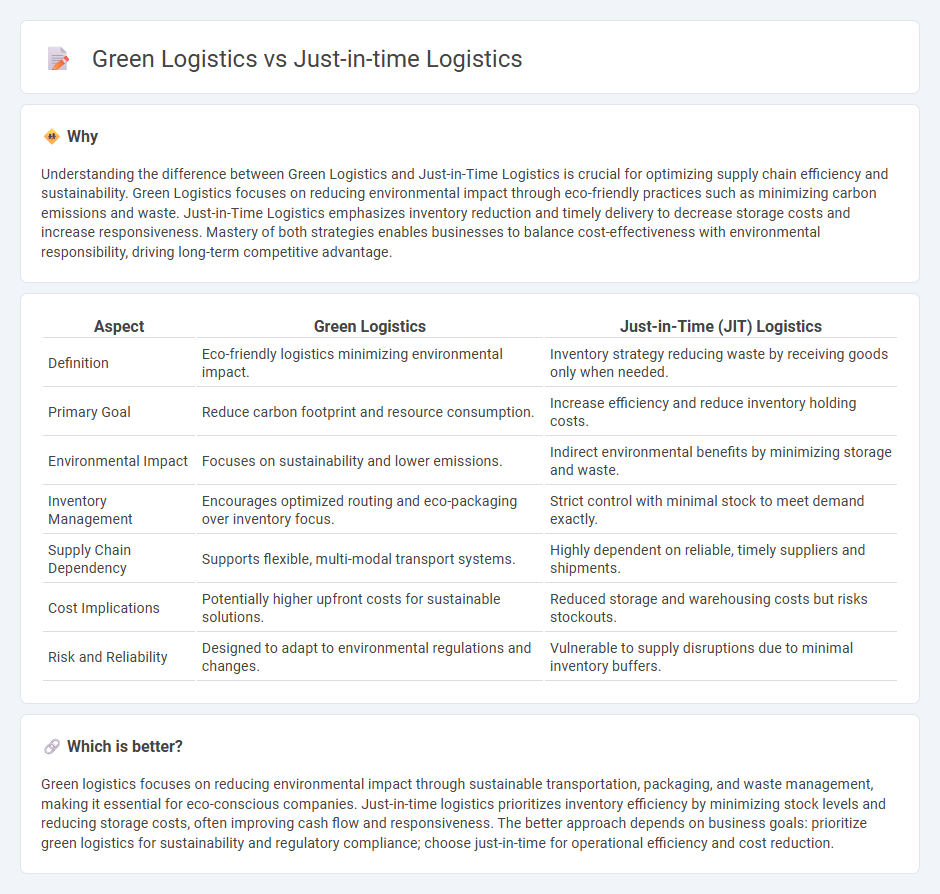
Green logistics reduces environmental impact by optimizing transportation routes and using eco-friendly packaging, while Just-in-time logistics focuses on minimizing inventory costs and enhancing supply chain efficiency through timely deliveries. Both strategies aim to improve operational performance but differ in prioritizing sustainability versus cost reduction. Explore the key benefits and challenges of Green logistics and Just-in-time logistics to understand their roles in modern commerce.
Why it is important
Understanding the difference between Green Logistics and Just-in-Time Logistics is crucial for optimizing supply chain efficiency and sustainability. Green Logistics focuses on reducing environmental impact through eco-friendly practices such as minimizing carbon emissions and waste. Just-in-Time Logistics emphasizes inventory reduction and timely delivery to decrease storage costs and increase responsiveness. Mastery of both strategies enables businesses to balance cost-effectiveness with environmental responsibility, driving long-term competitive advantage.
Comparison Table
| Aspect | Green Logistics | Just-in-Time (JIT) Logistics |
|---|---|---|
| Definition | Eco-friendly logistics minimizing environmental impact. | Inventory strategy reducing waste by receiving goods only when needed. |
| Primary Goal | Reduce carbon footprint and resource consumption. | Increase efficiency and reduce inventory holding costs. |
| Environmental Impact | Focuses on sustainability and lower emissions. | Indirect environmental benefits by minimizing storage and waste. |
| Inventory Management | Encourages optimized routing and eco-packaging over inventory focus. | Strict control with minimal stock to meet demand exactly. |
| Supply Chain Dependency | Supports flexible, multi-modal transport systems. | Highly dependent on reliable, timely suppliers and shipments. |
| Cost Implications | Potentially higher upfront costs for sustainable solutions. | Reduced storage and warehousing costs but risks stockouts. |
| Risk and Reliability | Designed to adapt to environmental regulations and changes. | Vulnerable to supply disruptions due to minimal inventory buffers. |
Which is better?
Green logistics focuses on reducing environmental impact through sustainable transportation, packaging, and waste management, making it essential for eco-conscious companies. Just-in-time logistics prioritizes inventory efficiency by minimizing stock levels and reducing storage costs, often improving cash flow and responsiveness. The better approach depends on business goals: prioritize green logistics for sustainability and regulatory compliance; choose just-in-time for operational efficiency and cost reduction.
Connection
Green logistics and Just-in-time (JIT) logistics are interconnected through their focus on efficiency and environmental sustainability in supply chain management. JIT logistics minimizes inventory levels and reduces waste by delivering goods precisely when needed, which aligns with green logistics goals of lowering carbon emissions and energy consumption. Integrating these approaches optimizes transportation routes, decreases storage requirements, and promotes eco-friendly practices such as the use of electric vehicles and sustainable packaging.
Key Terms
Inventory Management
Just-in-time (JIT) logistics streamlines inventory management by minimizing stock levels and reducing storage costs, ensuring materials arrive precisely when needed to avoid overproduction and waste. Green logistics emphasizes sustainable inventory practices by optimizing supply chains to lower carbon footprints, incorporating eco-friendly packaging and energy-efficient transportation to reduce environmental impact. Explore in-depth strategies to balance efficient inventory control with sustainability goals for improved operational performance.
Carbon Footprint
Just-in-time logistics minimizes inventory storage by synchronizing supply with demand, reducing excess transportation but potentially increasing rapid shipment frequency and emissions. Green logistics prioritizes sustainable practices such as optimizing routes, using eco-friendly vehicles, and minimizing carbon footprint through energy-efficient operations. Explore in-depth strategies to balance efficiency and environmental impact in modern supply chain management.
Supply Chain Efficiency
Just-in-time logistics minimizes inventory holding by synchronizing supply deliveries with production schedules, reducing waste and improving supply chain responsiveness. Green logistics emphasizes eco-friendly practices such as optimizing transport routes, using sustainable packaging, and reducing carbon emissions throughout the supply chain. Explore in-depth strategies to balance supply chain efficiency with environmental sustainability for a competitive advantage.
Source and External Links
Just-in-Time (JIT) Logistics Strategy - Translogistics Inc - Just-in-Time (JIT) logistics is a supply chain strategy delivering goods precisely when needed to reduce inventory costs and waste, requiring close collaboration and accurate demand forecasting.
What is Just-in-Time (JIT) Logistics? Principles and Benefits - AsstrA - JIT logistics synchronizes deliveries with production needs to improve efficiency, minimize waste, and optimize transport times through precise planning and supplier cooperation.
Just-in-Time (JIT) Logistics and Distribution: Meaning and Examples - Originating from the Toyota Production System, JIT logistics coordinates material arrivals with production schedules, lowering inventory and enhancing supply chain responsiveness with strong supply chain collaboration.
 dowidth.com
dowidth.com